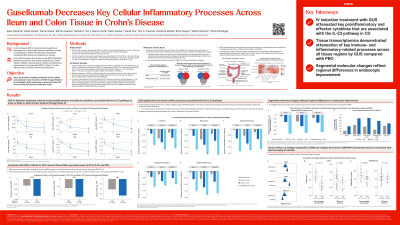Sunday Poster Session
Category: IBD
P0950 - Guselkumab Decreases Key Cellular Inflammatory Processes Across Ileum and Colon Tissue in Crohn’s Disease
Sunday, October 27, 2024
3:30 PM - 7:00 PM ET
Location: Exhibit Hall E

Has Audio

Patrick Branigan, BS
Janssen Research & Development, LLC
Spring House, PA
Presenting Author(s)
Dylan Richards, PhD1, Swati Venkat, PhD1, Darren Ruane, PhD1, Martha Zeeman, MS1, Natalie A. Terry, MD, PhD1, Marion Vetter, MD1, Mario Gomez, MD, PhD1, Daniel Cua, PhD1, Tom C. Freeman, PhD2, Bradford McRae, PhD1, Brian G.. Feagan, MD3, Walter Reinisch, MD, PhD4, Patrick Branigan, BS1
1Janssen Research & Development, LLC, Spring House, PA; 2Janssen Research & Development, LLC, a Johnson & Johnson Company, Spring House, PA; 3Western University, London, ON, Canada; 4Medical University of Vienna, Vienna, Wien, Austria
Introduction: Crohn’s disease (CD) has significant heterogeneity in phenotypic disease expression, making it challenging to define molecular mechanisms associated with disease and response to therapy. Here we evaluate the cellular/molecular mechanism of guselkumab (GUS), an IL-23p19 subunit antagonist, in participants with CD from the GALAXI Ph2b study (NCT03466411).
Methods: Serum samples were evaluated at baseline, Week (WK) 4 and WK12 for proinflammatory and effector cytokines from participants receiving intravenous (IV) GUS 200, 600, or 1200 mg induction therapy (n=131 combined) or placebo (PBO; n=44) with ≥1 paired sample at WK0 with WK4 or WK12. A subset of participants with ileal narrowing or history of stricture were evaluated for collagen formation and degradation serum biomarkers. Transcriptional profiling was performed with bulk RNA sequencing (RNAseq) in rectum (R), splenic flexure (SF), and terminal ileum (TI) samples (n=241 at baseline). An objective tissue-based Molecular Activity Score (MAS) was used to identify inflamed samples. Inflamed tissue (GUS n=140; PBO n=51) was used to assess regional molecular profiles which were correlated with paired Global Histologic Activity Score (GHAS) and Simple Endoscopic Score for CD (SES-CD). Transcriptional modules using published single cell RNAseq data were used to assess changes in baseline inflamed tissue associated with specific cellular/immune processes at WK12.
Results: Local MAS per region showed highest correlations with paired GHAS from adjacent biopsies (R 0.72; SF 0.63; TI 0.70), followed by SES-CD in local segments (R 0.69; TI 0.58). Compared with PBO at WK12, GUS reduced ileum and colon RNA expression levels of IL-17A, IL-22, and IFNγ at WK12 (P≤0.05). GUS significantly decreased cellular processes associated with epithelial inflammation, inflammatory fibroblast, myeloid biology, interferon response, and the IL-23 pathway. Regional molecular change was greatest in colon, followed by rectum and ileum. Serum collagen degradation biomarker C4M and the C3M/PRO-C3 ratio were associated with ileal narrowing and history of stricture at baseline (P≤0.001). GUS reduced serum SAA, CRP, and IL-22 as early as WK4 (P≤0.01) which further declined through WK12 (SAA, CRP, IL-6, IFNγ, IL-22, IL-17A; P≤0.001).
Discussion: GUS treatment attenuated key proinflammatory and effector cytokines associated with the IL-23 pathway in CD. Tissue transcriptomics showed attenuation of key immune/inflammatory processes across all tissue regions with GUS vs PBO.
Disclosures:
Dylan Richards, PhD1, Swati Venkat, PhD1, Darren Ruane, PhD1, Martha Zeeman, MS1, Natalie A. Terry, MD, PhD1, Marion Vetter, MD1, Mario Gomez, MD, PhD1, Daniel Cua, PhD1, Tom C. Freeman, PhD2, Bradford McRae, PhD1, Brian G.. Feagan, MD3, Walter Reinisch, MD, PhD4, Patrick Branigan, BS1. P0950 - Guselkumab Decreases Key Cellular Inflammatory Processes Across Ileum and Colon Tissue in Crohn’s Disease, ACG 2024 Annual Scientific Meeting Abstracts. Philadelphia, PA: American College of Gastroenterology.
1Janssen Research & Development, LLC, Spring House, PA; 2Janssen Research & Development, LLC, a Johnson & Johnson Company, Spring House, PA; 3Western University, London, ON, Canada; 4Medical University of Vienna, Vienna, Wien, Austria
Introduction: Crohn’s disease (CD) has significant heterogeneity in phenotypic disease expression, making it challenging to define molecular mechanisms associated with disease and response to therapy. Here we evaluate the cellular/molecular mechanism of guselkumab (GUS), an IL-23p19 subunit antagonist, in participants with CD from the GALAXI Ph2b study (NCT03466411).
Methods: Serum samples were evaluated at baseline, Week (WK) 4 and WK12 for proinflammatory and effector cytokines from participants receiving intravenous (IV) GUS 200, 600, or 1200 mg induction therapy (n=131 combined) or placebo (PBO; n=44) with ≥1 paired sample at WK0 with WK4 or WK12. A subset of participants with ileal narrowing or history of stricture were evaluated for collagen formation and degradation serum biomarkers. Transcriptional profiling was performed with bulk RNA sequencing (RNAseq) in rectum (R), splenic flexure (SF), and terminal ileum (TI) samples (n=241 at baseline). An objective tissue-based Molecular Activity Score (MAS) was used to identify inflamed samples. Inflamed tissue (GUS n=140; PBO n=51) was used to assess regional molecular profiles which were correlated with paired Global Histologic Activity Score (GHAS) and Simple Endoscopic Score for CD (SES-CD). Transcriptional modules using published single cell RNAseq data were used to assess changes in baseline inflamed tissue associated with specific cellular/immune processes at WK12.
Results: Local MAS per region showed highest correlations with paired GHAS from adjacent biopsies (R 0.72; SF 0.63; TI 0.70), followed by SES-CD in local segments (R 0.69; TI 0.58). Compared with PBO at WK12, GUS reduced ileum and colon RNA expression levels of IL-17A, IL-22, and IFNγ at WK12 (P≤0.05). GUS significantly decreased cellular processes associated with epithelial inflammation, inflammatory fibroblast, myeloid biology, interferon response, and the IL-23 pathway. Regional molecular change was greatest in colon, followed by rectum and ileum. Serum collagen degradation biomarker C4M and the C3M/PRO-C3 ratio were associated with ileal narrowing and history of stricture at baseline (P≤0.001). GUS reduced serum SAA, CRP, and IL-22 as early as WK4 (P≤0.01) which further declined through WK12 (SAA, CRP, IL-6, IFNγ, IL-22, IL-17A; P≤0.001).
Discussion: GUS treatment attenuated key proinflammatory and effector cytokines associated with the IL-23 pathway in CD. Tissue transcriptomics showed attenuation of key immune/inflammatory processes across all tissue regions with GUS vs PBO.
Disclosures:
Dylan Richards: Janssen Research & Development, LLC – Employee, Stock Options.
Swati Venkat: Janssen Research & Development, LLC – Employee, Stock Options.
Darren Ruane: Janssen Research & Development, LLC – Employee, Stock Options.
Martha Zeeman: Janssen Research & Development, LLC – Employee, Stock Options.
Natalie A. Terry: Janssen Research & Development, LLC – Employee, Stock Options.
Marion Vetter: Johnson & Johnson – Employee, Stock Options, Stock-publicly held company(excluding mutual/index funds).
Mario Gomez: Janssen Research & Development, LLC – Employee, Stock Options.
Daniel Cua: Janssen Research & Development, LLC – Employee, Stock Options.
Tom C. Freeman: Janssen – Employee, Stock Options.
Bradford McRae: Janssen Research & Development, LLC – Employee, Stock Options.
Brian Feagan: AbbVie – Advisory Committee/Board Member, Consultant, Speakers Bureau. AbolerIS – Consultant. AgomAB Therapeutics – Consultant. Allianthera – Consultant. Amgen – Advisory Committee/Board Member, Consultant. AnaptysBio – Advisory Committee/Board Member, Consultant. Applied Molecular Transport Inc – Advisory Committee/Board Member, Consultant. Arena Pharma – Consultant. Atomwise – Consultant. Avoro Capital Advisors – Consultant. Axio Research – Advisory Committee/Board Member. BioJamp – Consultant. Biora Therapeutics – Consultant. Boehringer Ingelheim – Advisory Committee/Board Member, Consultant. Boxer – Consultant. Celgene/Bristol Myers Squibb – Advisory Committee/Board Member, Consultant. Celsius Therapeutics – Consultant. Connect BioPharma – Consultant, stock or other ownership interest. Cytoki – Consultant. Disc Medicine – Consultant. Duality – Consultant. EcoR1 Capital – Advisory Committee/Board Member, Consultant. Equillium – Consultant. Ermium – Consultant. First Wave – Consultant. First Word Group – Consultant. Galapagos – Consultant. Galen Atlantica – Consultant. Genentech/Roche – Advisory Committee/Board Member, Consultant. Gilead – Consultant. GlaxoSmithKline – Advisory Committee/Board Member, Consultant. Gossamer Pharma – Consultant, Stock Options. Hinge Bio – Consultant. Hot Spot Therapeutics – Consultant. Imhotex – Consultant. Immunic Therapeutics – Consultant. InDex Pharmaceuticals – Advisory Committee/Board Member, Consultant. JAKAcademy – Consultant. Janssen – Advisory Committee/Board Member, Consultant, Speakers Bureau. Japan Tobacco Inc. – Consultant. Kaleido Biosciences – Consultant. L.E.K. Consulting – Consultant. Landos Biopharma – Consultant. Leadiant – Consultant. Lenczner Slaght – Consultant, payment for expert testimony. LifeSci Capital – Consultant. Lilly – Advisory Committee/Board Member, Consultant. Lument AB – Consultant. Millennium – Consultant. MiroBio – Advisory Committee/Board Member, Consultant. Morgan Lewis – Consultant, payment for expert testimony. Morphic Therapeutics – Advisory Committee/Board Member, Consultant. Mylan – Consultant. OM Pharma – Consultant. Origo BioPharma – Advisory Committee/Board Member, Consultant. Orphagen – Consultant. Pandion Therapeutics – Consultant. Pendopharm – Consultant. Pfizer Inc – Advisory Committee/Board Member, Consultant, Grant/Research Support. Play to Know AG – Consultant. Progenity – Advisory Committee/Board Member, Consultant. Prometheus – Advisory Committee/Board Member, Consultant. Protagonist – Consultant. PTM Therapeutics – Consultant. Q32 Bio – Consultant. Rebiotix – Consultant. REDX – Advisory Committee/Board Member, Consultant. Roche – Consultant. Sandoz – Consultant. Sanofi – Advisory Committee/Board Member, Consultant. Seres Therapeutics – Consultant. Silverback Therapeutics – Consultant. Surrozen Inc. – Consultant. Takeda – Advisory Committee/Board Member, Consultant, Speakers Bureau. Teva – Advisory Committee/Board Member, Consultant. Thelium – Consultant. Tigenix – Consultant. Tillotts Pharma – Advisory Committee/Board Member, Consultant. Ventyx Biosciences – Consultant. VHSquared Ltd – Consultant. Viatris – Consultant. Ysios – Consultant. Ysopia – Consultant. Zealand Pharma – Consultant.
Walter Reinisch: AbbVie – Advisory Committee/Board Member, Consultant, Grant/Research Support, Speakers Bureau. Amgen – Advisory Committee/Board Member, Consultant. AOP Orphan – Consultant. Boehringer Ingelheim – Advisory Committee/Board Member, Consultant. Bristol Myers Squibb – Advisory Committee/Board Member, Consultant. Calyx – Consultant. Celltrion – Advisory Committee/Board Member, Consultant, Speakers Bureau. Eli Lilly – Consultant. Ferring – Speakers Bureau. Galapagos – Advisory Committee/Board Member, Consultant, Speakers Bureau. Gilead – Consultant. Index Pharma – Consultant. Janssen – Advisory Committee/Board Member, Consultant, Grant/Research Support, Speakers Bureau. Medahead – Consultant. Microbiotica – Consultant. MSD – Speakers Bureau. Pfizer – Advisory Committee/Board Member, Consultant, Speakers Bureau. Roche – Speakers Bureau. Sandoz – Grant/Research Support. Sanofi – Grant/Research Support. Sobi – Speakers Bureau. Takeda – Consultant, Grant/Research Support, Speakers Bureau.
Patrick Branigan: Johnson & Johnson – Employee, Stock Options, Stock-publicly held company(excluding mutual/index funds).
Dylan Richards, PhD1, Swati Venkat, PhD1, Darren Ruane, PhD1, Martha Zeeman, MS1, Natalie A. Terry, MD, PhD1, Marion Vetter, MD1, Mario Gomez, MD, PhD1, Daniel Cua, PhD1, Tom C. Freeman, PhD2, Bradford McRae, PhD1, Brian G.. Feagan, MD3, Walter Reinisch, MD, PhD4, Patrick Branigan, BS1. P0950 - Guselkumab Decreases Key Cellular Inflammatory Processes Across Ileum and Colon Tissue in Crohn’s Disease, ACG 2024 Annual Scientific Meeting Abstracts. Philadelphia, PA: American College of Gastroenterology.
